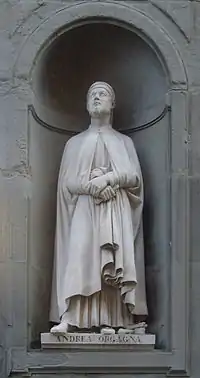
Statue of Andrea Orcagna in the Uffizi outside gallery in Florence carved by Niccolò Bazzanti at Pietro Bazzanti e Figlio Art Gallery, Florence
Andrea di Cione di Arcangelo (c. 1308 – 25 August 1368), better known as Orcagna, was an Italian painter, sculptor, and architect active in Florence. He worked as a consultant at the Florence Cathedral and supervised the construction of the façade at the Orvieto Cathedral.[1] His Strozzi Altarpiece (1354–57) is noted as defining a new role for Christ as a source of Catholic doctrine and papal authority.[2]
Works
Orcagna's works include:
- "Altarpiece of the Redeemer" (1354–57) in the Strozzi di Mantova Chapel at Santa Maria Novella, Florence
- The tabernacle in Orsanmichele (finished 1359) which was regarded as "the most perfect work of its kind in Italian Gothic".[3]
- His fresco The Triumph of Death inspired Franz Liszt's masterwork Totentanz.
- His fresco Crucifixion with a multitude of angels surrounding the cross, portrayed on a dark background and a few fragments of the Last Supper (1365).[4]
The mosaic decoration and the rose window of the cathedral of Orvieto is attributed to Orcagna, who had become Master of the Works in 1359.
Pupils
Among Orcagna's pupils and legacy were:
- Nello di Vanni, a Pisan painter of the 14th century, who also worked for the Campo Santo. Nello di Vanni is conjectured to be identical with Bernardo Nello or Giovanni Falcone.[5]
- Tommaso del Mazza, called Tomasso di Marco by Giorgio Vasari[6]
- Jacopo di Cione, brother of Andrea and mainly sculptor and architect[7]
References
- ↑ "UFFIZI GALLERY". www.museumsinflorence.com.
- ↑ Eimerl, Sarel (1967). The World of Giotto: c. 1267–1337. et al. Time-Life Books. p. 187. ISBN 0-900658-15-0.
- ↑ "Orcagna". Catholic Encyclopedia.
- ↑ "Cenacolo by Andrea". www.visitflorence.com.
- ↑ Bryan, Michael (1889). Walter Armstrong; Robert Edmund Graves (eds.). Dictionary of Painters and Engravers, Biographical and Critical. Vol. II L-Z. London: George Bell and Sons. p. 586.
- ↑ Le vite de' più eccellenti pittori, scultori ed architettori, Volume 1, by Giorgio Vasari, Editor G. C. Sansoni, (1906); page 609.
- ↑ Vasari, page 610.
External links
Wikimedia Commons has media related to Andrea Orcagna.
- Middleton, John Henry (1911). . In Chisholm, Hugh (ed.). Encyclopædia Britannica. Vol. 20 (11th ed.). Cambridge University Press. pp. 165–167.
This article is issued from Wikipedia. The text is licensed under Creative Commons - Attribution - Sharealike. Additional terms may apply for the media files.